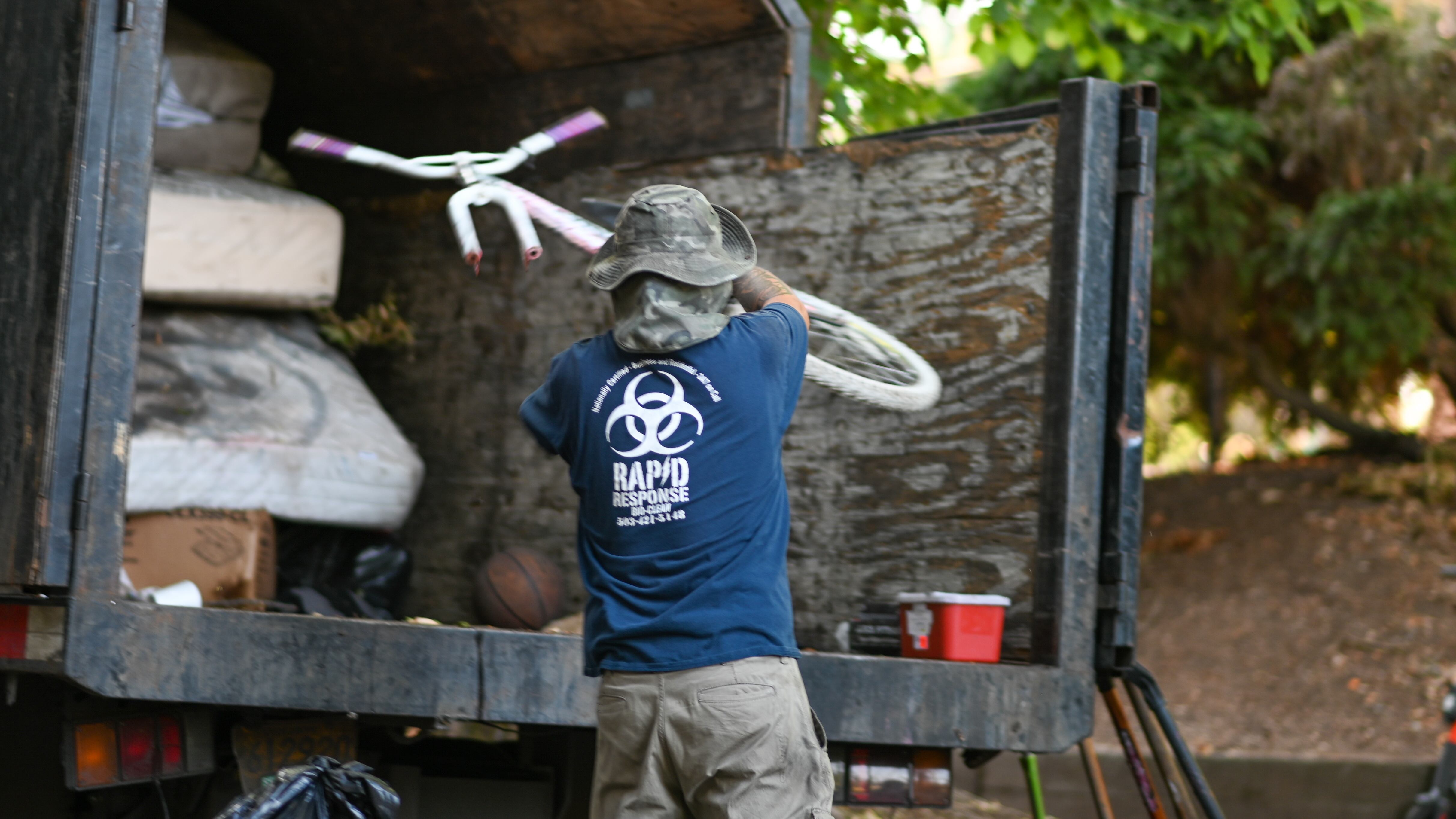On July 29, television news trucks set up shop along Laurelhurst Park to witness the city’s removal of a 50-tent homeless camp.
It was a delicate operation: the high-profile eviction of people from an iconic park where they had slept for months. That afternoon, the Portland City Council breathed a sigh of relief at a largely peaceful event that resulted in at least 65 people being offered emergency shelter, and three getting the cars they sleep in towed to another location for free.
That week, the city conducted 11 other sweeps that received much less media attention.
Moving west along Southeast Powell Boulevard from 79th Avenue, city contractors rousted campers from small parking lots lining the road. In one of those parking strips along Powell at 75th, a man rocked back and forth on the pavement, screaming and sobbing.
“They take my things, they’re just taking my things,” he moaned. “Why do they keep doing this?”
It wasn’t clear if he was referring to a camp sweep. But other people living in the parking lot said city contractors had removed the camp two days before.
After a yearlong slowdown, Portland is again sweeping out large homeless camps from its sidewalks, parks and wetlands. The average number of sweeps per week has tripled since earlier this year, according to public documents reviewed by WW.
A spokesperson for the Portland Office of Management and Finance, the bureau that oversees sweeps, tells WW that’s the new normal: It plans to conduct 10 to 15 camp removals a week for the foreseeable future, up from the four to six sweeps at the beginning of the year.
That’s still a fraction of the average of 40 homeless camps that were swept each week before the COVID-19 pandemic began, according to the OMF spokesperson.
City commissioners tell WW that this middle ground is the result of a carefully crafted policy that sets strict parameters for when and where camps are removed.
But it’s also true that the compromise chosen by City Hall—more sweeps than Portland has seen in a year, but far fewer than the previous average—reflects a political balancing act between the values of a populace that views sweeps as cruel to the downtrodden and an increasing number of residents and business owners who believe the city’s inattention to large encampments threatens neighborhood safety.
“The new protocols attempt to balance the need to manage public space,” Commissioner Mingus Mapps tells WW, “and the reality that there is currently not enough shelter space or deeply affordable housing to transition every person off the street.”
Not everyone thinks the city has struck the right balance. Kaia Sand, executive director of Street Roots, says the city is wrong to resume sweeps at any scale without giving unhoused people clear directions about where they can go. (The city’s promised “safe rest sites” are still months from opening.)
“It’s still quite vague,” Sand says. “What the city really needs to do is give unhoused people a map that shows where it would be safe to sleep.”
When the pandemic hit, the city temporarily halted all sweeps of homeless encampments, conducting only trash and debris pickups. This fall and winter, camp removals remained uncommon—sometimes none in a week.
During that time, the size of the camps grew.
“Due to our COVID-19 protocols, we significantly reduced the number of campsite removals we performed. As a result, we saw increased numbers of campsites, and some of them got much bigger than we typically see,” says a spokesperson for the Office of Management and Finance.
The latest official count in 2019 showed that over 2,000 people are living unsheltered in Multnomah County. On the week of July 18, city documents say, officials received 1,758 calls or emails about 205 camps—and another 523 complaints about people sleeping in vehicles.
In June, the City Council, for the first time ever, passed an ordinance that codified the standards used by the city team that coordinates sweeps to determine which camps were “high impact” and “low impact”. (City officials dislike the term “sweeps” and, in documents, call them “camp removals.”)
Camps where complaints are documented are ranked by the city on a scale of 0 to 5, based on a list of factors that include drug use, the presence of trash as it affects the neighborhood, proximity to schools, parks or homes, the size of the camp, the environmental impact, and reports of crime or violence.
A 2018 decision by the 9th U.S. Circuit Court of Appeals in Martin v. Boise ruled that local governments could not criminalize homelessness if they weren’t providing other housing alternatives.
But Juan Chavez, a lawyer with the Oregon Justice Resource Center, says Portland has circumvented the ruling by arguing that its sweeps are done for safety reasons. The city says camps that qualify for a sweep must contain biohazardous waste, give rise to credible allegations of criminal activity, or consist of eight or more structures, among other criteria.
Last week, the city’s list of camps earmarked for sweeps expanded again.
Commissioner Jo Ann Hardesty presented new rules for removing campers from urban forested areas, in order to reduce wildfire risk amid a parched summer.
WW asked Hardesty this week if she thinks the city has struck the right balance in deciding which camps to remove.
“Not yet,” Hardesty replied. “But what I hope we showed at Laurelhurst is that you can actually remove a houseless camp with empathy and people skills and deescalation. It was heartbreaking to have to remove that camp. But I think, with all the City Council working cooperatively together, we were able to do it in a way that caused the least amount of harm possible.”
Raven Drake, an outreach worker at Street Roots, wants the city to show that much care in all of its camp removals. “[At] Laurelhurst, all the commissioners were there with us having conversations. A big camp like Laurelhurst is in the public eye,” Drake says. “But when it’s some camp off of Powell and 82nd, then there isn’t the same outreach to them that you’d do at Laurelhurst, where everyone’s yelling about it.”
The people who’ve been swept say the treatment they receive varies. At 75th and Powell, a homeless couple named Shea and Michael sat in their van.
Shea, who has been homeless for four years, says she’s been swept 15 times. She’s usually gotten 24 to 72 hours’ notice to leave. If campers haven’t left by then, that’s when police come.
“The Rapid Response [Bioclean] guys are actually pretty cool, they feel for us,” Shea says. “They actually bought a few things from me because I needed cash at the time. I had this mini vintage shopping cart, and one of the guys said his daughter would love it and bought it for $5.”
But when the police come after the notice expires? “They’re looking down their noses at us.”
Others say the removal of a camp only stops people from living there for a matter of days.
While that will not likely be the case for Laurelhurst because of the vocal nature of the neighborhood and the media coverage that’s engulfed it, people with experience on the streets know to pack their belongings and return a few days later.
Paul Woods, a homeowner who lives along Powell at 60th Avenue, says the camp in a parking lot near his house was swept last month. It was repopulated just days later. It now has close to 20 tents and 10 cars. He thinks the camp poses no danger—and the sweeps are pointless.
“My grandkids come over and we play in the yard, and I’ve never had anybody not respect my boundaries,” Woods says. “They’ve moved everybody at least three times in the past two years. Within days, they’re back.”

